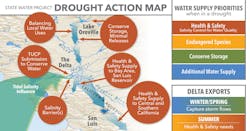Calif. announces 2022 water allocations, expecting third dry year
The Department of Water Resources (DWR) announced its initial State Water Project (SWP) allocation for 2022 yesterday, along with several steps to manage the state’s water supply. The Department anticipates a third dry year, with reservoirs at or near historic lows.
Given the unprecedented drought conditions, the SWP’s initial allocation for December 1 will focus on the health and safety needs of the 29 water agencies that contract to receive SWP’s supplies. DWR advised these water agencies to expect that their initial allocation will focus on these health and safety water needs — and that the SWP will not be planning water deliveries through its typical process until the state has a clearer picture of its hydrologic and reservoir conditions going into the spring.
DWR is focused on prioritizing water supply in four categories: water for health and safety needs and Delta salinity control; water for endangered species; water to reserve in storage; and water for additional supply allocations if the hydrology allows.
“Despite a wet start to the water year, conditions have dried out since that first storm and we are still planning for a below-average water year. That means we need to prepare now for a dry winter and severe drought conditions to continue through 2022,” said DWR Director Karla Nemeth. “We will be working with our federal partners and SWP contractors to take a conservative planning approach to balance limited water supplies with the needs of residents, businesses, and the environment.”
In addition to limiting the initial allocation to health and safety needs, DWR is making plans to adjust SWP operations for this winter and spring. DWR is capturing and storing water when possible in Lake Oroville and south of the Delta in San Luis Reservoir to increase available supplies for 2022 and plans to continue doing so throughout the winter.
Health and safety demands for the Bay Area and Central and Southern California will be met with water available from the Delta as well as water stored in San Luis Reservoir. Water in Lake Oroville will be reserved to maintain Delta water quality, protect endangered species, and meet senior water right needs. Beyond minimal exports to meet South Bay health and safety needs, water stored in Lake Oroville will be used for south of Delta deliveries only if hydrology conditions improve. DWR plans to conserve as much storage as possible in Oroville in anticipation of a third dry year, and potentially a dry 2023.
Also, yesterday, DWR along with the U.S. Bureau of Reclamation, submitted a new Temporary Urgency Change Petition (TUCP) to the State Water Resources Control Board. If approved, the petition would allow for the State Water Project and the Central Valley Project to operate under modifications to the water quality and water right permit requirements in the Delta from February through April 2022, if needed.
These modifications might be needed to conserve water in Lake Oroville to ensure minimum health and safety water supplies if dry conditions persist. If significant rain comes within the next few months, these modifications might not be necessary.
DWR is also delaying the removal of its Emergency Drought Salinity Barrier in the Delta. The rock barrier across West False River was scheduled to be removed by November 30 — however, drought conditions have persisted. Because of this, DWR decided that leaving the barrier in place will enable a more efficient drought response in spring 2022 if needed. DWR plans to create a notch in the barrier in January 2022 to allow for fish passage and boat traffic until April 2022.
“It is going to take a multi-pronged approach to successfully respond to these unprecedented drought conditions,” said Nemeth.
Each year, DWR provides the initial State Water Project allocation by December 1 based on available water storage and projected water supply demands. Allocations are updated monthly as snowpack and runoff information is assessed, with a final allocation typically determined in May or June.
The lowest initial allocations were 5 percent in 2010 and 2014. Last year, the initial SWP allocation was 10 percent — however, due to increasing dry conditions, the final allocation was lowered to 5 percent.

